You are using an out of date browser. It may not display this or other websites correctly.
You should upgrade or use an alternative browser.
You should upgrade or use an alternative browser.
T-14 MBT Armata
- Thread starter BLACKEAGLE
- Start date
BLACKEAGLE
SENIOR MEMBER
BLACKEAGLE
SENIOR MEMBER
BLACKEAGLE
SENIOR MEMBER
http:///attachments/artt-jpg.218627/
BLACKEAGLE
SENIOR MEMBER
BLACKEAGLE
SENIOR MEMBER
BLACKEAGLE
SENIOR MEMBER
BLACKEAGLE
SENIOR MEMBER
BLACKEAGLE
SENIOR MEMBER
It's 20 years ahead of the West - and it WON'T blow up 'like its predecessor': Brains behind Russia's new robotic tank reveals secrets of machine at centre of $500BILLION military upgrade
Published: 10:00 GMT, 12 June 2015 | Updated: 13:10 GMT, 12 June 2015
Bristling with state of the art weaponry, armed with a remote control turret, and equipped with outer armour that explodes on impact to stop shells reaching the crew inside - this is the new Russian tank that its makers claim is 20 years ahead of anything in the West.
The Armata T-14 tank, produced as part of Russia's £250billion military update programme, even has the capability to become completely automated - making it the first fully robotic tank in the world.
The war machine was among the new vehicles unveiled by Putin at Russia's Victory Day parade in Moscow last month, a muscle-flexing exercise designed to boost patriotism among Russians, and intimidate the country's opponents.
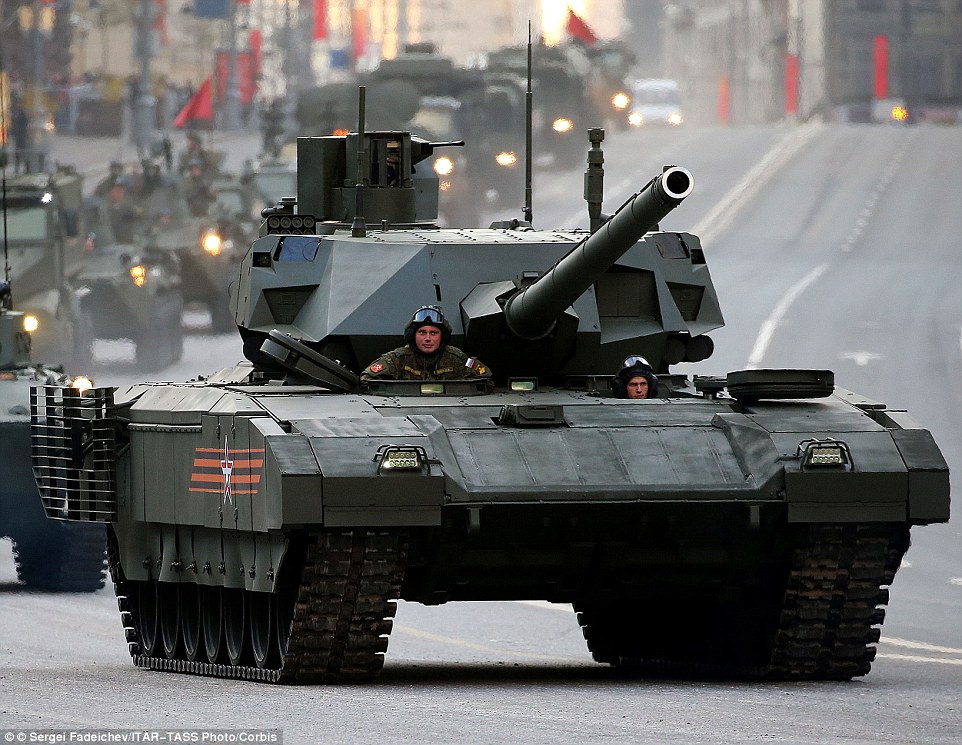
New kid on the block: The creators of Russia's new Aramta T-14 tank, which was seen for the first time at the Victory Day parade last month, claim it is 20 years ahead of anything in the West
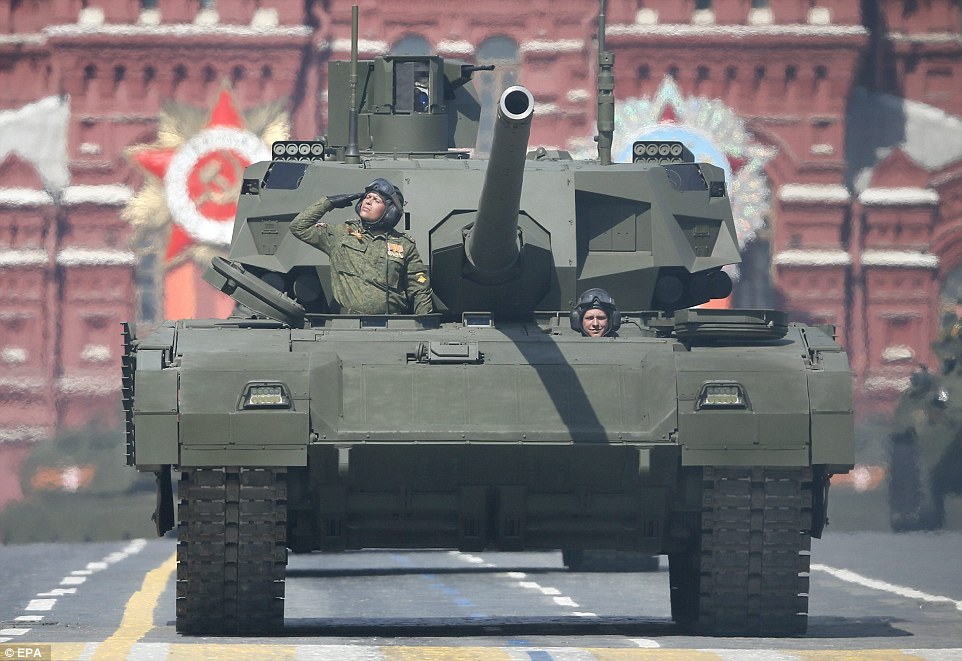
High-tech: The Armata's designers have revealed it has a full remote-control turret, meaning it could eventually be possible to remove the crew altogether and make the tank fully automated - the first of its kind in the world
Speaking about the new tank, Viktor Murakhovsky, a retired army colonel who is now the editor of the Arsenal Otechestva military magazine, said the Armata represented a huge leap forward in Russian design, but also came at a huge cost.
He said: 'The Armata is significantly more expensive than the current models. But it far excels all Russian and foreign tanks on the cost-efficiency basis.'
Terlikov's deputy, 35-year old Ilya Demchenko, said that the onboard computer system performs most of the technical functions, allowing the crew to focus on key tasks. 'For the crew, it's like playing a video game, taking some final moves and making decisions,' he said.
De Larrinaga agreed that the Armata represented a technological advance for Russia.
'The crew has a much better chance of surviving if the tank is destroyed,' de Larrinaga said. 'If you look at old Russian tank designs, they had a habit of blowing up quite spectacularly with pretty poor chances for crew survivability.'
The previous Russian tank, the T-90, was designed to have a low profile, light armour, and to be extremely manoeuvrable on the battlefield. It weighed 20 tons less than the American Abrams tank, but that meant it was also extremely vulnerable if hit by high-explosive rounds.
By comparison, the new Armata T-14 has a high ground clearance and increased armour, especially on the tank's traditionally soft underbelly in order to protect the crew from mines.
The Russian government also claim it is protected by a shield of high-tech weaponry, including sensors which can detect incoming rounds, then automatically fire countermeasures to knock them off target.
If these systems work, then it puts the Russians at least a generation ahead in terms of defensive technology, as such systems are only in their infancy on British and American tanks.
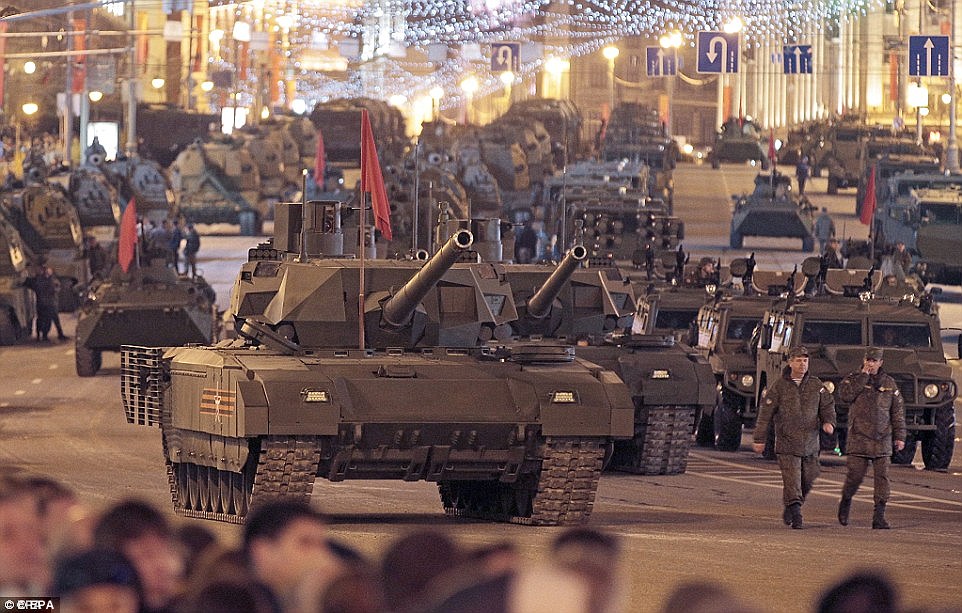
Packing a punch: The Armata is currently fitted with a 125mm smooth bore cannon, similar to British and American weapons, but its creators say it is ready to be upgraded with a much more powerful 154mm cannon
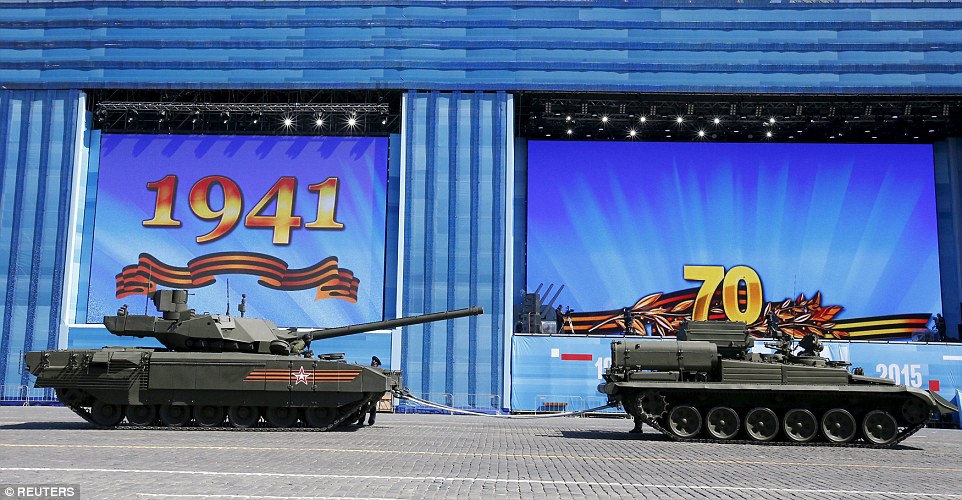
Leap ahead: It has also been revealed that the Armata (left) is bristling with defence systems designed to knock incoming shells off target, and armour which is designed to explode on impact, detonating rockets before they reach the crew
The tank's main turret is also operated by remote control, rather than having the crew situated inside it, improving their chances of survival if the tank is hit. Instead the crew are locked inside an armoured pod, which is also separate from the tank's ammunition store.
If the outer armour of the tank is hit, it is designed to explode outwards, potentially detonating any explosive rounds fired at it, and preventing heavy shells from penetrating inside and killing the crew.
Its designers also boast that the main weapon, a 125mm smooth-bore cannon, which can already fire four miles further than Britain's Challenger 2 tank, is ready to be replaced with a much more powerful 154mm weapon, though this is 'not necessary at the moment'.
The new tank is the result of Vladimir Putin pouring money into the country's defence budget which has risen by around 33 per cent to £38billion, at a time when Britain is considering cutting its budget to below 2 per cent of GDP.
However, Putin's expensive arms build-up faces major hurdles as Russia's economy sinks under the weight of Western sanctions and falling oil prices.
The programme, which aims to create 2,300 new tanks, hundreds of aircraft and missiles and dozens of navy ships, was conceived back at the time when Russia's coffers were brimming with money from the lucrative oil trade.
However, since then a catastropic fall in the price of oil has caused the value of the ruble to crash, while Western sanctions - particularly on trading military technology with Russia - continue to bite.
Nick de Larrinaga, Europe Editor for IHS Jane's Defence Weekly, predicted that Russia would find it hard to replace Western military know-how.
'They have been relying on Western sub-systems, electro-optical systems is a good example, but also computer chips and things like that, which Russia doesn't make,' he said. 'How Russia goes about trying to replace these systems is going to be a really big challenge.'
The rupture of military ties with Ukraine dealt another heavy blow to Putin's re-armament effort. Ukrainian factories had exported a wide array of weapons and sub-systems to Russia, and officials acknowledged that it would take years and massive resources to launch production of their equivalent at home.
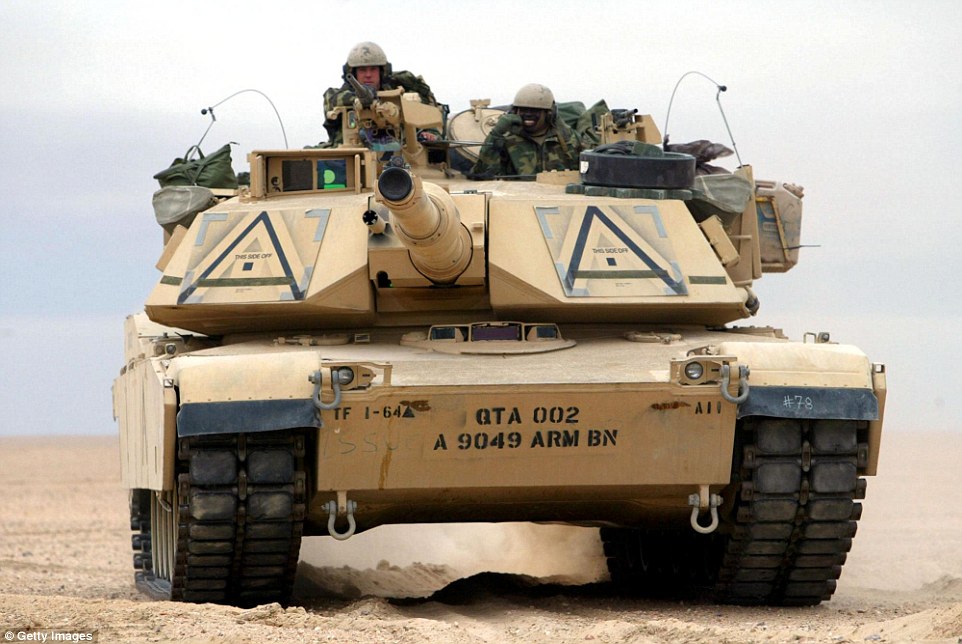
Competition: The Armata tank is part of a £250billion update of the Russian military, and the new tank was designed as a competitor to the American Abrams (pictured)
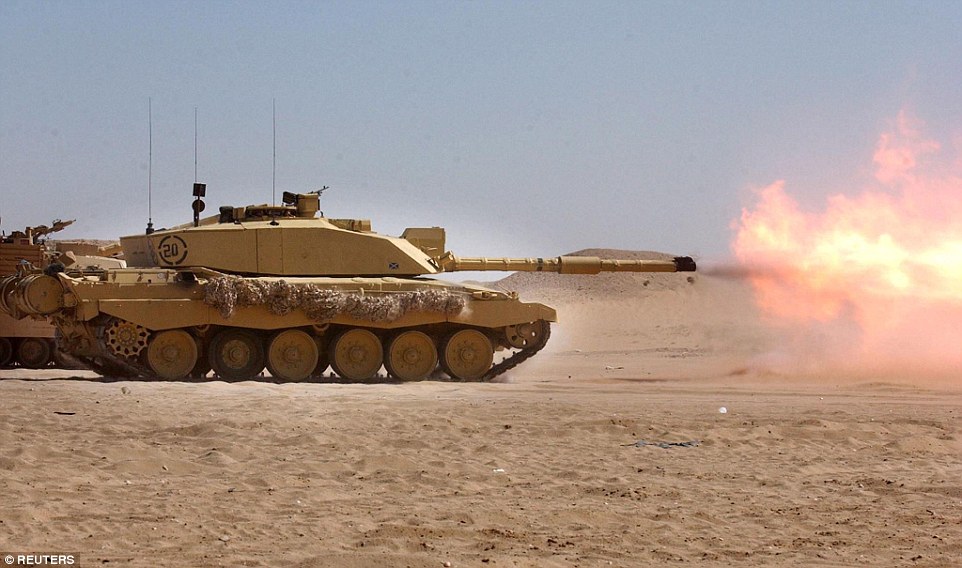
Outclassed: If the details on Russia's new tank are correct, then it will be faster, more heavily armed, and better defended than Britain's Challenger 2 tank (pictured here in Kuwait)
Since Soviet times, Ukraine specialized in building helicopter engines, and Putin said that Russia was setting up a capacity to produce them at home.
It could be even more challenging to substitute another Ukrainian product, ship turbines. Its refusal to deliver them has derailed the commissioning of new Russian navy ships.
Last month, the Armata starred in the Victory Day parade on Red Square, becoming an emblem of the country's resurgent military power. Dmitry Rogozin, a deputy prime minister in charge of weapons modernization, likened Russia to a 'big Armata' and claimed that the new tank is 15-20 years ahead of the current Western designs.
Speaking in a recent live TV talk show, Rogozin also used armor as a symbol to issue a bold threat to the West - showing how military hardware can also be a powerful weapon in the Kremlin's propaganda war.
'Tanks don't need visas!' Rogozin declared, in a reference to Western travel bans and economic sanctions against Russia. Amid the tensions with the West, Putin emphasized the need for the nation's defense industries to quickly shed their dependence on imported components.
The Armata's price hasn't been announced, but some observers speculated that the new tank could be as expensive as a fighter jet, too heavy a burden for the struggling economy. There are no reliable cost estimates of the tank.
The tank's chief designer, Andrei Terlikov, 52, shrugged off such claims, saying that the Armata's price will drop significantly once it enters full-scale production. 'In the end, the price of those machines will be affordable,' Terlikov told The Associated Press in his first interview with foreign media.
Speaking at his office at the mammoth UralVagonZavod factory in the Ural Mountains, one of the biggest industrial plants in the world, Terlikov described the Armata as a 'decisive step toward more advanced unmanned machines, including those which could operate autonomously in combat.'
He emphasized that the Armata uses only domestically produced parts. 'From the very start, we have set the task to rely on our own resources,' he said.
PUTIN'S BILLION-DOLLAR WAR MACHINE: THE TANK RUSSIA CLAIMS IS 20 YEARS AHEAD OF WESTERN RIVALS
REMOTE-CONTROLLED TURRET
The Armata is groundbreaking in having a remote-controlled turret and an internal capsule for the crew that is isolated from ammunition and fuel, a layout that could significantly increase the chances for the crew survival if the tank is hit.
While previous Russian tanks featured a low silhouette and compact size at the expense of crew comfort, the Armata is significantly bigger and heavier. Designers say they put special emphasis on ergonomics, so that even very tall people feel comfortable in it. One designer said the new tank is as pleasant and easy to drive as a modern SUV.
COMPUTERIZED CONTROLS
The Armata features a digital control system that directs its movement, tracks targets and activates the tank's defense systems. It frees the crew from performing routine tasks to allow it to focus on key combat functions. "For the crew, it's like playing a video game," said Ilya Demchenko, one of the Armata's designers.
The Armata's chief designer, Andrei Terlikov, said that the new technologies built into the Armata could make it possible in the future to build a fully robotic vehicle that would operate autonomously on the battlefield.
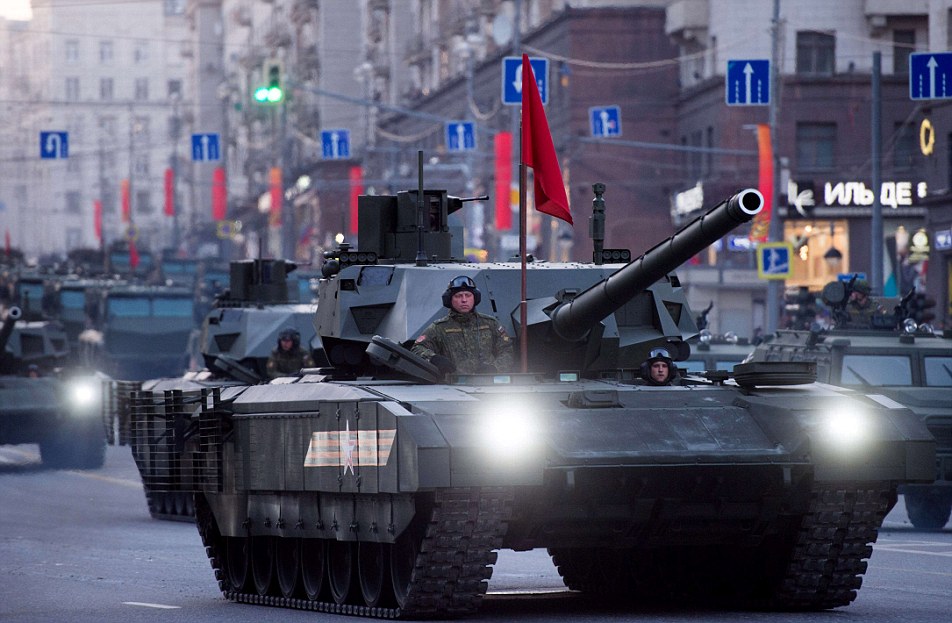
MODULAR DESIGN
The new tank is part of a family of new armored vehicles built on a unified platform that has a structure based on replaceable modules. This helps lower production costs and leaves room for further development.
The Armata family includes a heavy armored infantry vehicle that offers the same level of protection as the tank, and various support machines.
SUPERIOR PROTECTION
The Armata uses a new type of armor, which designers say is significantly more resistant to enemy fire, although they are coy about its specific characteristics. On top of that, the vehicle is protected by an improved version of reactive armor, which explodes on impact to stop a projectile from reaching the main layer of armor.
The Armata is also equipped with a so-called active protection system, forming an outer perimeter of its defenses. When the system spots an enemy projectile, it fires a round to destroy it or knock it off its path.
SUPER CANNON
The current version of the Armata is equipped with standard-caliber 125-mm cannon, similar to those used on current tanks, which can fire both regular shells and rockets.
Designers say that a much more powerful 152-mm cannon could be easily fitted to the Armata in the future - although they say there is no need for that yet.
Russian Armata tank 'is 20 years ahead of anything in the West' | Daily Mail Online
- New Armata T-14 tank was unveiled at Victory Day parade in Russia last month as part of muscle-flexing exercise
- Now designers have revealed features including sensor to knock incoming shells of target and improved armour
- Also claim the war machine has the capability to become fully automated - making it the world's first robotic tank
- Armata is part of £250billion military update in Russia which has seen defence spending jump 33 per cent
Published: 10:00 GMT, 12 June 2015 | Updated: 13:10 GMT, 12 June 2015
Bristling with state of the art weaponry, armed with a remote control turret, and equipped with outer armour that explodes on impact to stop shells reaching the crew inside - this is the new Russian tank that its makers claim is 20 years ahead of anything in the West.
The Armata T-14 tank, produced as part of Russia's £250billion military update programme, even has the capability to become completely automated - making it the first fully robotic tank in the world.
The war machine was among the new vehicles unveiled by Putin at Russia's Victory Day parade in Moscow last month, a muscle-flexing exercise designed to boost patriotism among Russians, and intimidate the country's opponents.

New kid on the block: The creators of Russia's new Aramta T-14 tank, which was seen for the first time at the Victory Day parade last month, claim it is 20 years ahead of anything in the West

High-tech: The Armata's designers have revealed it has a full remote-control turret, meaning it could eventually be possible to remove the crew altogether and make the tank fully automated - the first of its kind in the world
Speaking about the new tank, Viktor Murakhovsky, a retired army colonel who is now the editor of the Arsenal Otechestva military magazine, said the Armata represented a huge leap forward in Russian design, but also came at a huge cost.
He said: 'The Armata is significantly more expensive than the current models. But it far excels all Russian and foreign tanks on the cost-efficiency basis.'
Terlikov's deputy, 35-year old Ilya Demchenko, said that the onboard computer system performs most of the technical functions, allowing the crew to focus on key tasks. 'For the crew, it's like playing a video game, taking some final moves and making decisions,' he said.
De Larrinaga agreed that the Armata represented a technological advance for Russia.
'The crew has a much better chance of surviving if the tank is destroyed,' de Larrinaga said. 'If you look at old Russian tank designs, they had a habit of blowing up quite spectacularly with pretty poor chances for crew survivability.'
The previous Russian tank, the T-90, was designed to have a low profile, light armour, and to be extremely manoeuvrable on the battlefield. It weighed 20 tons less than the American Abrams tank, but that meant it was also extremely vulnerable if hit by high-explosive rounds.
By comparison, the new Armata T-14 has a high ground clearance and increased armour, especially on the tank's traditionally soft underbelly in order to protect the crew from mines.
The Russian government also claim it is protected by a shield of high-tech weaponry, including sensors which can detect incoming rounds, then automatically fire countermeasures to knock them off target.
If these systems work, then it puts the Russians at least a generation ahead in terms of defensive technology, as such systems are only in their infancy on British and American tanks.

Packing a punch: The Armata is currently fitted with a 125mm smooth bore cannon, similar to British and American weapons, but its creators say it is ready to be upgraded with a much more powerful 154mm cannon

Leap ahead: It has also been revealed that the Armata (left) is bristling with defence systems designed to knock incoming shells off target, and armour which is designed to explode on impact, detonating rockets before they reach the crew
The tank's main turret is also operated by remote control, rather than having the crew situated inside it, improving their chances of survival if the tank is hit. Instead the crew are locked inside an armoured pod, which is also separate from the tank's ammunition store.
If the outer armour of the tank is hit, it is designed to explode outwards, potentially detonating any explosive rounds fired at it, and preventing heavy shells from penetrating inside and killing the crew.
Its designers also boast that the main weapon, a 125mm smooth-bore cannon, which can already fire four miles further than Britain's Challenger 2 tank, is ready to be replaced with a much more powerful 154mm weapon, though this is 'not necessary at the moment'.
The new tank is the result of Vladimir Putin pouring money into the country's defence budget which has risen by around 33 per cent to £38billion, at a time when Britain is considering cutting its budget to below 2 per cent of GDP.
However, Putin's expensive arms build-up faces major hurdles as Russia's economy sinks under the weight of Western sanctions and falling oil prices.
The programme, which aims to create 2,300 new tanks, hundreds of aircraft and missiles and dozens of navy ships, was conceived back at the time when Russia's coffers were brimming with money from the lucrative oil trade.
However, since then a catastropic fall in the price of oil has caused the value of the ruble to crash, while Western sanctions - particularly on trading military technology with Russia - continue to bite.
Nick de Larrinaga, Europe Editor for IHS Jane's Defence Weekly, predicted that Russia would find it hard to replace Western military know-how.
'They have been relying on Western sub-systems, electro-optical systems is a good example, but also computer chips and things like that, which Russia doesn't make,' he said. 'How Russia goes about trying to replace these systems is going to be a really big challenge.'
The rupture of military ties with Ukraine dealt another heavy blow to Putin's re-armament effort. Ukrainian factories had exported a wide array of weapons and sub-systems to Russia, and officials acknowledged that it would take years and massive resources to launch production of their equivalent at home.

Competition: The Armata tank is part of a £250billion update of the Russian military, and the new tank was designed as a competitor to the American Abrams (pictured)

Outclassed: If the details on Russia's new tank are correct, then it will be faster, more heavily armed, and better defended than Britain's Challenger 2 tank (pictured here in Kuwait)
Since Soviet times, Ukraine specialized in building helicopter engines, and Putin said that Russia was setting up a capacity to produce them at home.
It could be even more challenging to substitute another Ukrainian product, ship turbines. Its refusal to deliver them has derailed the commissioning of new Russian navy ships.
Last month, the Armata starred in the Victory Day parade on Red Square, becoming an emblem of the country's resurgent military power. Dmitry Rogozin, a deputy prime minister in charge of weapons modernization, likened Russia to a 'big Armata' and claimed that the new tank is 15-20 years ahead of the current Western designs.
Speaking in a recent live TV talk show, Rogozin also used armor as a symbol to issue a bold threat to the West - showing how military hardware can also be a powerful weapon in the Kremlin's propaganda war.
'Tanks don't need visas!' Rogozin declared, in a reference to Western travel bans and economic sanctions against Russia. Amid the tensions with the West, Putin emphasized the need for the nation's defense industries to quickly shed their dependence on imported components.
The Armata's price hasn't been announced, but some observers speculated that the new tank could be as expensive as a fighter jet, too heavy a burden for the struggling economy. There are no reliable cost estimates of the tank.
The tank's chief designer, Andrei Terlikov, 52, shrugged off such claims, saying that the Armata's price will drop significantly once it enters full-scale production. 'In the end, the price of those machines will be affordable,' Terlikov told The Associated Press in his first interview with foreign media.
Speaking at his office at the mammoth UralVagonZavod factory in the Ural Mountains, one of the biggest industrial plants in the world, Terlikov described the Armata as a 'decisive step toward more advanced unmanned machines, including those which could operate autonomously in combat.'
He emphasized that the Armata uses only domestically produced parts. 'From the very start, we have set the task to rely on our own resources,' he said.
PUTIN'S BILLION-DOLLAR WAR MACHINE: THE TANK RUSSIA CLAIMS IS 20 YEARS AHEAD OF WESTERN RIVALS
REMOTE-CONTROLLED TURRET
The Armata is groundbreaking in having a remote-controlled turret and an internal capsule for the crew that is isolated from ammunition and fuel, a layout that could significantly increase the chances for the crew survival if the tank is hit.
While previous Russian tanks featured a low silhouette and compact size at the expense of crew comfort, the Armata is significantly bigger and heavier. Designers say they put special emphasis on ergonomics, so that even very tall people feel comfortable in it. One designer said the new tank is as pleasant and easy to drive as a modern SUV.
COMPUTERIZED CONTROLS
The Armata features a digital control system that directs its movement, tracks targets and activates the tank's defense systems. It frees the crew from performing routine tasks to allow it to focus on key combat functions. "For the crew, it's like playing a video game," said Ilya Demchenko, one of the Armata's designers.
The Armata's chief designer, Andrei Terlikov, said that the new technologies built into the Armata could make it possible in the future to build a fully robotic vehicle that would operate autonomously on the battlefield.

MODULAR DESIGN
The new tank is part of a family of new armored vehicles built on a unified platform that has a structure based on replaceable modules. This helps lower production costs and leaves room for further development.
The Armata family includes a heavy armored infantry vehicle that offers the same level of protection as the tank, and various support machines.
SUPERIOR PROTECTION
The Armata uses a new type of armor, which designers say is significantly more resistant to enemy fire, although they are coy about its specific characteristics. On top of that, the vehicle is protected by an improved version of reactive armor, which explodes on impact to stop a projectile from reaching the main layer of armor.
The Armata is also equipped with a so-called active protection system, forming an outer perimeter of its defenses. When the system spots an enemy projectile, it fires a round to destroy it or knock it off its path.
SUPER CANNON
The current version of the Armata is equipped with standard-caliber 125-mm cannon, similar to those used on current tanks, which can fire both regular shells and rockets.
Designers say that a much more powerful 152-mm cannon could be easily fitted to the Armata in the future - although they say there is no need for that yet.
Russian Armata tank 'is 20 years ahead of anything in the West' | Daily Mail Online
